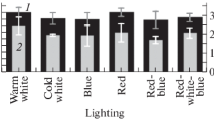Abstract
As the receiver of photoperiodic responses of plants is the phytochrome, it may be concluded that these responses are controlled also by the spectral composition of natural radiation, especially by the red and far red bands. The red radiation is affected by ozone “Chappuis-band absorption”, the far red by water vapor in the atmosphere “alpha-band absorption”. Using a rapid-scanning spectroradiometer, the measurements of the natural radiation were performed. The evident annual cycle of far red to red radiation ratio was found. The ratio has its maximum in the spring and minimum in the late summer and autumn. It seems to be probable that this cycle assists plants in making a distinction between spring and autumn.
Similar content being viewed by others
References
FITTER, A. H. and ASHMORE, C. J. (1974): Response of two Veronica species to a simulated woodland light climate. New Phytol., 73: 997–1001.
GATES, D. M. (1966): Spectral distribution of solar radiation at the earth's surface. Science, 151: 523–529.
GÓRSKI, T. (1975): Germination of seeds in the shadow of plants. Physiol. Plant. 34: 342–346.
GÓRSKI, T. (1976): Red and far red radiation at sunset: Annual cycle and dependence on precipitable water. Naturwissenschaften, 63: 530.
GÓRSKI, T. and GÓRSKA, K. V. (1979): Inhibitory effects of full daylight on the germination ofLactuca sativa L. Planta, 144: 121–124.
HARTMANN, K. M. (1966): A general hypothesis to interpret “high energy phenomena” of photomorphogenesis on the basis of phytochrome. Photochem. Photobiol., 5: 349–366.
HENDERSON, S. T. and HODGKISS, D. (1963): The spectral energy distribution of daylight. Brit. J. appl. Phys., 14: 125–130.
HOLMES, M. G. and SMITH, H. (1975): The function of phytochrome in plants growing in the natural environment. Nature (Lond.), 254: 512–514.
HOLMES, M. G. and SMITH, H. (1977a): The function of phytochrome in the natural environment-I. Characterization of daylight for studies in photomorphogenesis and photoperiodism. Photochem. Photobiol., 25: 533–538
HOLMES, M. G. and SMITH, H. (1977b): The function of phytochrome in the natural environment-IV. Light quality and plant development. Photochem. Photobiol., 25: 551–557.
JUNGES, W. (1957): Die jährliche Niederschlagsverteilung als entscheidender Faktor bei der photoperiodischen Anpassung der Pflanzen. Gartenbauwissenschaft, 22: 527–540.
KADMAN-ZAHAVI, A. (1977): Dependence of the effects of end-of-day red or far red irradiations on the duration of the following dark periods. Plant Physiol., Suppl. 59: 49.
KENDRICK, R. E. and SPRUIT, C. J. P. (1977): Phototransformations of phytochrome. Photochem. Photobiol., 26: 201–214.
MOHR, H. (1972): Lectures on Photomorphogenesis. Springer, Berlin-Heidelberg-New York.
MORGAN, D. C. and SMITH, H. (1978): The relationship between phytochrome photoequilibrium and development in light grown Chenopodium album. Planta, 142: 187–194.
ROBINSON, N. (1966): (ed.): Solar Radiation. Elsevier Publ. Comp., Amsterdam-London-New York.
SAWHNEY, R. (1977): Nature of light requirement for the flowering ofChenopodium rubrum L. (Ecotype 60°47′N). Planta, 133: 97–109.
SMITH, H. and HOLMES, M. G. (1977): The function of phytochrome in the natural environment-III. Measurement and calculation of phytochrome photoequilibria. Photochem. Photobiol., 25: 547–550.
STOUTJESDIJK, P. (1972): Spectral transmission curves of some type of leaf canopies with a note on seed germination. Acta Bot. neerl., 21: 185–191.
TASKER, R. and SMITH, H. (1977): The function of phytochrome in the natural environment-V. Seasonal changes in the radiant energy quality in woodlands. Photochem. Photobiol., 26: 487–491.
VAN DER VEEN, R. (1970): The importance of the red-far red antagonism in photoblastic seeds. Acta Bot. neerl., 19: 809–812.
VINCE-PRUE, D. (1975): Photoperiodism in Plants. McGraw-Hill, New York.
Author information
Authors and Affiliations
Rights and permissions
About this article
Cite this article
Górski, T. Annual cycle of the red and far red radiation. Int J Biometeorol 24, 361–365 (1980). https://doi.org/10.1007/BF02250579
Issue Date:
DOI: https://doi.org/10.1007/BF02250579



